This page shows the official definitions of SI units, including a history of previous definitions. This list includes some units that are technically not SI units but are used with SI (such as the liter) or that are obsolete (such as the micron).
This list uses American English spellings. SI generally does not specify unit spellings or pronunciations, so they vary with language and dialect, but the symbols are standardized.
With few exceptions, the series of definitions for a unit did not change the actual “size” of the unit, but merely provided a better or more precise way of defining its size.
The entries below use the modern-day unit names even when the original wording did not. For example, the ampere’s definition originally used the phrase “MKS unit of force” because the name newton had not yet been assigned, but the definition shown on this page uses the latter name.
Most entries indicate the year when a definition became official, although the year is sometimes approximate.
Table of contents
Ampere (A)
1948: “The ampere is that constant current which, if maintained in two straight parallel conductors of infinite length, of negligible circular cross-section, and placed 1 meter apart in vacuum, would produce between these conductors a force equal to 2 × 10−7 newtons per meter of length.” [9th CGPM; 1946 CIPM]
Are (a)
1879: Are is an obsolete special name for 100 m2.
Note
The are, pronounced like “air,” is obsolete, but the hectare, equal to 10 000 m2, is still used for measuring areas of land.
Becquerel (Bq)
1975: “The special name for the SI unit of activity: becquerel, symbol Bq, equal to one reciprocal second.” [15th CGPM, Resolution 8]
Candela (cd)
1979: “The candela is the luminous intensity, in a given direction, of a source that emits monochromatic radiation of frequency 540 × 1012 hertz and that has a radiant intensity in that direction of 1/683 watt per steradian.” [16th CGPM, Resolution 3]
Previous definitions
1968: “The candela is the luminous intensity, in the perpendicular direction, of a surface of 1/600 000 square meter of a black body at the temperature of freezing platinum under a pressure of 101 325 pascals.” [13th CGPM, Resolution 5]
1948: “The value of the candela is such that the brightness of the full radiator at the temperature of solidification of platinum is 60 candelas per square centimeter.” [9th CGPM; 1946 CIPM]
Note
This unit was originally called the new candle, but it was renamed candela, generally pronounced with the accent on the second syllable, in 1948. The name new candle was officially declared obsolete in 1968.
Coulomb (C)
1948: “The coulomb is the quantity of electricity carried in 1 second by a current of 1 ampere.” [9th CGPM; 1946 CIPM]
Day (d)
1 day is 24 hours or 86 400 seconds.
Degree Celsius (°C)
1954: “The 10th Conférence Générale des Poids et Mesures decides to define the thermodynamic temperature scale by choosing the triple point of water as the fundamental fixed point, and assigning to it the temperature 273.16 kelvins, exactly.” [10th CGPM, Resolution 3]
Previous definitions
1948: “The zero of the centesimal thermodynamic scale must be defined as the temperature 0.0100 degree below that of the triple point of water.” [9th CGPM, Resolution 3]
Notes
The plural of “degree Celsius” is “degrees Celsius.” The “C” should be capitalized. There should be no space between the characters of its unit symbol, °C, although there should be space before it.
The term degree centigrade was a synonym for this unit until 1948: “From three names (‘degree centigrade,’ ‘centesimal degree,’ ‘degree Celsius’) proposed to denote the degree of temperature, the CIPM [and 9th CGPM] has chosen ‘degreeCelsius.’ ”
Farad (F)
1948: “The farad is the capacitance of a capacitor between the plates of which there appears a potential difference of 1 volt when it is charged by a quantity of electricity of 1 coulomb.” [9th CGPM; 1946 CIPM]
Gray (Gy)
1975: “[The] special name for the SI unit of ionizing radiation: gray, symbol Gy, equal to one joule per kilogram.” [15th CGPM, Resolution 9]
Hectare (ha)
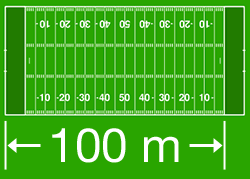
An American football field is almost exactly 100 meters from one end line to the opposite goal line. Imagine a square of that length on each side, and you’ve got an area of one hectare.
1879: Are is an obsolete special name for 100 m2. The hectare, which is not obsolete, is 100 ares (10 000 m2) and is used for measuring land area.
Notes
“Hectare” is normally pronounced so as to rhyme with “air.”
“Hectare” is one of the few cases in which a vowel is elided from what would otherwise be spelled “hectoare.”
Henry (H)
1948: “The henry is the inductance of a closed circuit in which an electromotive force of 1 volt is produced when the electric current in the circuit varies uniformly at the rate of 1 ampere per second.” [9th CGPM; 1946 CIPM]
Hertz (Hz)
1960: The SI unit of frequency, 1 hertz is 1/s. [11th CGPM, Resolution 12]
Note
The plural of “hertz” is “hertz.”
Hour (h)
1 hour is 60 minutes or 3600 seconds.
Joule (J)
1948: “The joule is the work done when the point of application of 1 newton moves a distance of 1 meter in the direction of the force.” [9th CGPM; 1946 CIPM]
Katal (kat)
1999: “Adopts the special name katal, symbol kat, for the SI unit mole per second to express catalytic activity, especially in the fields of medicine and biochemistry.” [21st CGPM, Resolution 7]
Kelvin (K)
1967: “The kelvin, unit of thermodynamic temperature, is the fraction 1/273.16 of the thermodynamic temperature of the triple point of water.” [13th CGPM, Resolution 4]. In addition, “the same name and the same symbol are used to express a temperature interval, [although] a temperature interval may also be expressed in degrees Celsius.” [13th CGPM, Resolution 3]
Because “the temperature of the triple point depends on the relative amount of isotopes of hydrogen and oxygen present in the sample of water used [and] this effect is now one of the major sources of the observed variability between different realizations of the water triple point,” the definition of the kelvin was clarified in 2007 by adding a note:
“This definition refers to water having the isotopic composition defined by the following amount-of-substance ratios: 0.000 155 76 mole of 2H per mole of 1H, 0.000 379 9 mole of 17O per mole of 16O, and 0.002 005 2 mole of 18O per mole of 16O.” [23rd CGPM, Resolution 10]
Previous definitions
1954: “The 10th Conférence Générale des Poids et Mesures decides to define the thermodynamic temperature scale by choosing the triple point of water as the fundamental fixed point, and assigning to it the temperature 273.16 kelvins, exactly.” [10th CGPM, Resolution 3]
Notes
This unit was called the degree Kelvin, symbol °K, until 1967, when the name kelvin, symbol K, replaced it. The old forms, as well as the symbol “deg,” were officially declared obsolete in 1980.
Kilogram (kg)
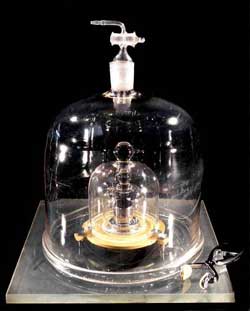
The international prototype of the kilogram at the BIPM.
1889: “This prototype shall henceforth be considered as the unit of mass,” referring to a prototype made of an alloy of platinum with 10% iridium. [1st CGPM]
Notes
In 1901, the 3d CGPM emphasized that the kilogram is a unit of mass and defined a standard value for the constant g, declaring that:
- The kilogram is the unit of mass; it is equal to the mass of the international prototype of the kilogram;
- The word “weight” denotes a quantity of the same nature as a “force”: the weight of a body is the product of its mass and the acceleration due to gravity; in particular, the standard weight of a body is the product of its mass and the standard acceleration due to gravity;
- The value adopted in the International Service of Weights and Measures for the standard acceleration due to gravity is 980.665 cm/s2, value already stated in the laws of some countries.
In everyday use, “weight” is a synonym for “mass”: You weigh something to determine its mass, which you call its “weight,” measured in grams, kilograms, metric tons, or the like. See Is it “weight” or “mass”? in the FAQ.
Liter (L)
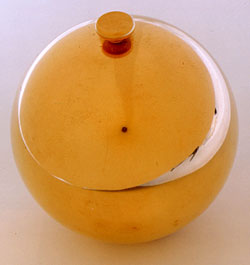
This kilogram/liter, made in 1905, was a hollow gold-plated brass sphere having a mass of approximately 1 kg and a volume of approximately 1 cubic decimeter (1 liter). (Details from NIST.)
1964: “The word ‘liter’ may be employed as a special name for the cubic decimeter [replacing its previous definition].” [12th CGPM, Resolution 6]
Previous definitions
1901: “The unit of volume, for high accuracy determinations, is the volume occupied by a mass of 1 kilogram of pure water, at its maximum density and at standard atmospheric pressure: this volume is called ‘liter.’ ” [3d CGPM]
1795: Liter is defined as a special name for the cubic decimeter.
Note
The original symbol for liter, adopted by the CIPM in 1879, was l (lowercase letter ell), and that was confirmed in Resolution 7 of the 9th CGPM in 1948. However, several countries later adopted a capital L to avoid confusion with the digit 1, and in 1979, Resolution 6 of the 16th CGPM decided “as an exception, to adopt the two symbols l and L as symbols to be used for the unit liter,” but said that “in the future only one of these two symbols should be retained.” As of 2013, no decision has been made, so both symbols remain correct.
Lumen (lm)
1948: “The lumen is the luminous flux emitted in unit solid angle (steradian) by a uniform point source having a luminous intensity of 1 candela.” [9th CGPM; 1946 CIPM]
Note
This unit was originally called the new lumen, but the “new” qualifier was later dropped.
Lux (lx)
1948?: The unit of illuminance, the lux is 1 lm/m2.
Meter (m)
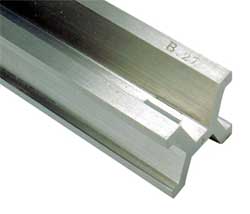
National Prototype Meter No. 27, made of platinum-iridium ca. 1890, was the U.S. primary national length standard from 1893–1960. (Details from NIST.)
1983: “The meter is the length of the path traveled by light in vacuum during a time interval of 1/299 792 458 of a second.” [17th CGPM, Resolution 1]
Previous definitions
1960: “The meter is the length equal to 1 650 763.73 wavelengths in vacuum of the radiation corresponding to the transition between the levels 2p10 and 5d5 of the krypton 86 atom.” [11th CGPM, Resolution 6]
1927: “The unit of length is the meter, defined by the distance, at 0°, between the axes of the two central lines marked on the bar of platinum-iridium kept at the Bureau International des Poids et Mesures and declared Prototype of the meter by the 1st Conférence Générale des Poids et Mesures, this bar being subject to standard atmospheric pressure and supported on two cylinders of at least one centimeter diameter, symmetrically placed in the same horizontal plane at a distance of 571 mm from each other.” [7th CGPM]
1889: “This prototype, at the temperature of melting ice, shall henceforth represent the metric unit of length,” referring to a prototype made of an alloy of platinum with 10% iridium. [1st CGPM]
1799: A platinum prototype.
1795: A brass prototype.
1793: The meter was defined as 1/10 000 000 of the distance from an Earth pole to the equator.
Metric ton (t)
1879: The metric ton is 1 Mg or 1000 kg.
Micron (µ)
1879: Micron, symbol µ, was a special name for the micrometer, but it was officially declared obsolete in 1968. [13th CGPM, Resolution 7]
Minute (min)
1 minute is 60 seconds.
Mole (mol)
1971: “The mole is the amount of substance of a system which contains as many elementary entities as there are atoms in 0.012 kilogram of carbon 12.” [14th CGPM, Resolution 3]
Newton (N)
1948: “The newton is the force which gives to a mass of 1 kilogram an acceleration of 1 meter per second, per second.” [9th CGPM; 1946 CIPM]
Note
Although the SI unit of force has always been the kg·m/s2, the name newton was not adopted until 1948.
Ohm (Ω)
1948: “The ohm is the electric resistance between two points of a conductor when a constant potential difference of 1 volt, applied to these points, produces in the conductor a current of 1 ampere, the conductor not being the seat of any electromotive force.” [9th CGPM; 1946 CIPM]
Note
The final vowel of the prefix is normally elided in “megohm” (MΩ) and “kilohm” (kΩ).
Pascal (Pa)
1971: The 14th CGPM adopted “pascal” as a special name for the SI unit newton per square meter.
Radian (rad)
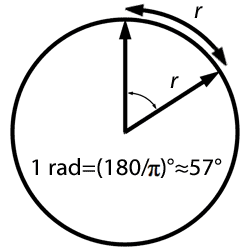
One radian, which is (180/π)° or about 57°, is the angle that, from the center of a circle, cuts an arc whose length equals the radius of the circle.
1960: The unit of plane angle, one radian is the angle subtended at the center of a circle by an arc of length equal to the radius of the circle. As such, its units are m/m, and so technically the radian is a special name for the number 1. For example, angular velocity in rad/s is, in base units, s-1.
Notes
The symbol rad was adopted at least as early as 1960, but the radian itself dates back at least as far as 1879.
The radian was originally categorized as a “supplementary unit,” distinct from the SI base units and derived units. In 1995 the CGPM officially eliminated the “supplementary unit” category, adopting a 1980 CIPM recommendation to classify the radian as a derived unit.
Second (s)
1967: “The second is the duration of 9 192 631 770 periods of the radiation corresponding to the transition between the two hyperfine levels of the ground state of the cesium 133 atom [at rest at a thermodynamic temperature of 0 K].” [13th CGPM, Resolution 1]
Previous definition
1960: “The second is the fraction 1/31 556 925.9747 of the tropical year for 1900 January 0 at 12 hours ephemeris time.” [11th CGPM, Resolution 9; 1956 CIPM]
Siemens (S)
1971: The 14th CGPM adopted “siemens” as a special name for the SI unit of conductance, reciprocal ohm.
Sievert (Sv)
1980: “[The] special name sievert, symbol Sv, for the SI unit of dose equivalent in the field of radioprotection. The sievert is equal to the joule per kilogram.” [16th CGPM, Resolution 5]
Steradian (sr)
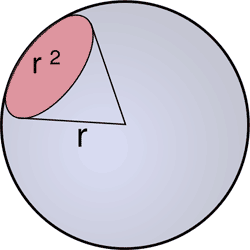
Wikimedia Commons
One steradian is the solid angle subtended at the center of a sphere of radius r by a portion of the surface of the sphere having an area r².
1960: The unit of solid angle, one steradian is the solid angle subtended at the center of the sphere by a portion of the surface whose area is equal to the square of the radius of the sphere. As such, its units are m²/m², and so technically the steradian is a special name for the number 1.
Notes
The symbol sr was adopted at least as early as 1960.
The steradian was originally categorized as a “supplementary unit,” distinct from the SI base units and derived units. In 1995 the CGPM officially eliminated the “supplementary unit” category, adopting a 1980 CIPM recommendation to classify the steradian as a derived unit.
Stere (st)
1879: Stere is an obsolete special name for 1 m3, once used for measuring firewood.
Note
The symbol for stere originally was s, later changed to st so as not to conflict with the symbol for the second. But the stere is now obsolete.
Tesla (T)
1960: The unit of magnetic flux density, the tesla is 1 Wb/m2. [11th CGPM, Resolution 12]
Volt (V)
1948: “The volt is the potential difference between two points of a conducting wire carrying a constant current of 1 ampere, when the power dissipated between these points is equal to 1 watt.” [9th CGPM; 1946 CIPM]
Watt (W)
1948: “The watt is the power which in one second gives rise to energy of 1 joule.” [9th CGPM; 1946 CIPM]
Weber (Wb)
1948: “The weber is the magnetic flux which, linking a circuit of one turn, would produce in it an electromotive force of 1 volt if it were reduced to zero at a uniform rate in 1 second.” [9th CGPM; 1946 CIPM]
Year
The year is not an SI unit and it is not approved for use with the SI. In practice, it is an important unit that is, ironically, directly relevant to SI in contexts such as, “Delegates from all Member States of the Meter Convention attend the General Conference which, at present, meets every four years.”
In common use, “year” usually refers to a calendar (or “civil”) year, i.e., the period of time between successive occurrences of a calendar date such as “1 January.” The actual duration of such a year varies due to leap years, among other things.
There is no official symbol for the year, but y, yr, and a are probably the most common; note that “a” conflicts with the symbol for the are.
Other definitions of the year, based on the interval between two successive passages of the Sun through a reference point, include the sidereal year, tropical year, and anomalistic year, all based on different astronomical reference points. These and other definitions of the year are explicitly identified when relevant.